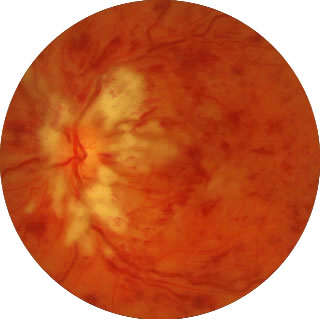Retinal Vein Occlusion
Retinal Vein Occlusion is when a blockage occurs in the eye, causing sudden but painless loss in vision. The retina is the thin lining at the back of the eye that allows us to see. When this becomes disturbed due to a blockage in one of the veins, it can disrupt the cells we use to detect light and begin causing serious problems within the eye.
There are two types of this condition, Central Retinal Vein Occlusion (CRVO) and Branch Retinal Vein Occlusion (BRVO).

What is Central Retinal Vein Occlusion?
Central Retinal Vein Occlusion is when a blockage occurs in the main central vein in the eye. When affecting this part of the eye, loss of vision tends to be more severe.
The main causes of CRVO include;
- Diabetes
- Hypertension
- Raised cholesterol
- Smoking
- Raised eye pressure
- Cardiovascular Atherosclerotic Disease
Typically, CRVO occurs in patients over 50 year of age. If the condition occurs in younger patients, this is more likely to be as a result of an underlying blood disorder.
Are there any symptoms?
Symptoms include a painless but sudden reduction in vision.
Complications of CRVO include;
- Growth of abnormal blood vessels – these fragile blood vessels can grow in the retina or iris, causing bleeding, further vision loss or glaucoma.
- Macular oedema – a thickening and swelling of the macula can occur as a result of damage to the retinal vessels causing leaking and blurring or distortion of vision.

caused by a CRVO

due to a CRVO
What is Branch Retinal Vein Occlusion?
Branch Retinal Vein Occlusion occurs when there is pressure on one of the four retinal veins, from an overlying artery. There are similar underlying factors associated as there are with CRVO, however, it is actually three times more common.
What symptoms should I look out for?
- Loss of vision – patients may experience a loss in part of their peripheral vision where the BRVO is located.
- Abnormal blood vessels – these can develop in the retina which may bleed if left untreated.
- Macular oedema can develop, significantly affecting vision.
What treatment is currently available for Retinal Vein Occlusion?
Unfortunately, there is currently no treatment available to reverse the blockage of the vein. However, symptoms can be managed and underlying issues such as diabetes, blood pressure or cholesterol issues and raised eye pressure can be better controlled to prevent further complications.
The following methods are used to manage both Central and Branch Retinal Vein Occlusion and prevent the condition occurring in the other eye:
Careful monitoring
Regular monitoring to assess growth of abnormal blood vessels is implemented, in order to avoid further vision impairment. If this does occur, laser treatment (PRP) can be given.
AntiVEGF therapy
AntiVEGF therapies such as Avastin, Eylea and Lucentis have been proven to treat macular oedema caused by RVO. Carried out with a course of injections, patients have seen a reduction in macular oedema and an improvement in vision.
Steroid therapy
Ozurdex is a type of steroid therapy involving a steroid implant being injected into the eye, proved to treat macular oedema due to RVO.
Macular laser
Small, light laser spots are applied to the area of macular swelling and can be effective in the reduction of the oedema and restoration of vision.
Visit one of our Hertfordshire clinics…
If you think you may have Retinal Vein Occlusion or are seeking treatment for the condition, visit one of our Hertfordshire clinics or book an appointment with Mr Venki Sundaram.

